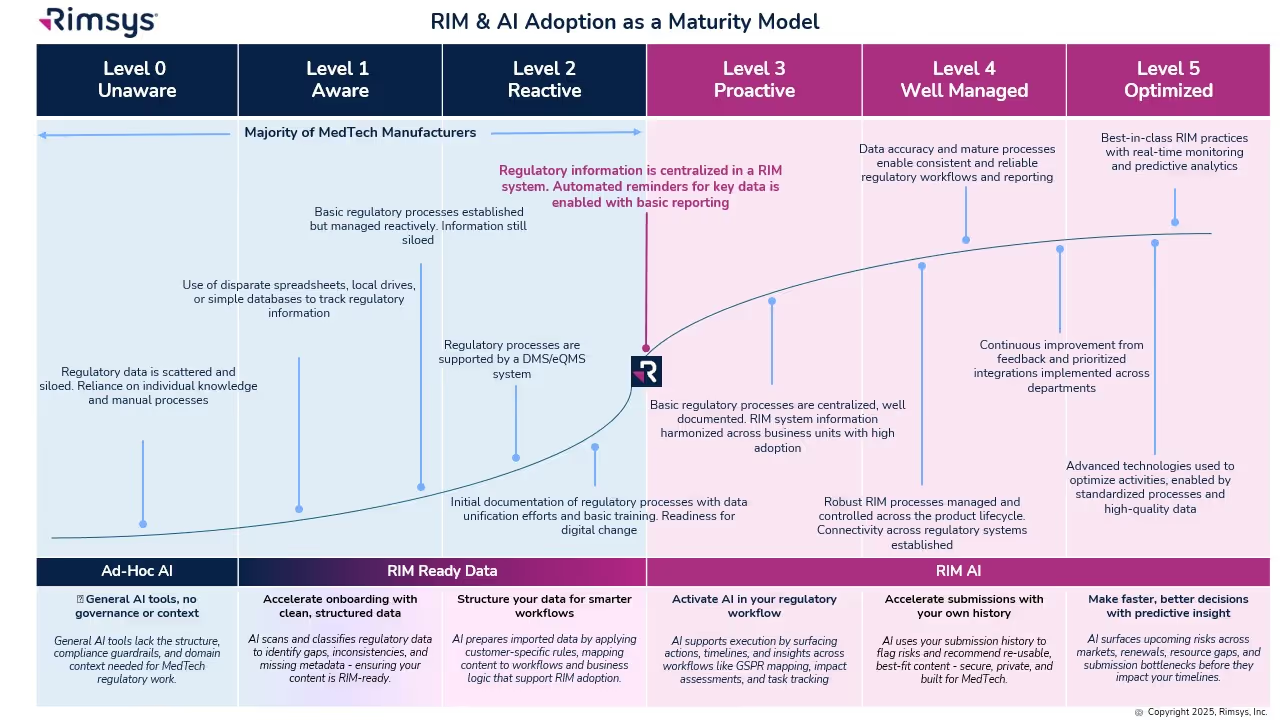
Regulatory affairs professionals at large medical device companies must manage heavy submission workloads, registrations for products currently on the market, and ever-changing regulatory requirements. Many RA teams are still relying on paper documents, spreadsheets, and other outdated tools and methods to complete this work, while others have taken steps toward digitization and automation of key processes.
Regulatory teams often struggle to find software tools designed specifically to help manage their regulatory projects. As a result, some RA teams attempt to repurpose software developed for other functions, such as electronic quality management systems (eQMS). While eQMS systems can provide some functionality that RA teams need, regulatory information management (RIM) software delivers a holistic platform designed to reduce administrative work and manage global compliance activities. In this post, we’ll compare eQMS and RIM software as they relate to regulatory compliance.
What is eQMS software?
Electronic quality management systems (eQMS) are software programs that help quality teams centrally store, monitor, and manage quality and compliance processes. These platforms are usually provided via cloud technology as software-as-a-service (SaaS) solutions. They aim to provide digitization and automation of critical tasks that quality teams traditionally handle manually, such as quality, compliance, and design processes. For medical device companies, these requirements are defined by multiple standards, most notably ISO 13485:2016, FDA 21 CFR Part 820, and the EU MDR.
Digitization and automation are growing trends in most industries, including regulatory affairs and quality management. As you know, medical device manufacturers, especially their quality and RA teams, must manage a large volume of data, of which accuracy and consistency are of the utmost importance. eQMS systems typically handle data and processes in support of the following:
- Document management
- Non-conformance tracking
- Audit management
- Risk management
- Corrective and preventive action (CAPA) management
- Training management
This means that while eQMS software provides some functions and certainly have information that RA teams can use, they are designed around the processes that quality teams are responsible for. RIM software, on the other hand, is designed specifically to help regulatory specialists work more effectively and efficiently.
What are RIM systems, and what do they do?
Regulatory information management (RIM) systems have been around for years in the pharmaceutical industry, but are relatively new in the medical device industry. Comprehensive RIM systems enable users to create a single source of truth for all data associated with regulatory submissions and registration management. These systems lighten the burden on RA teams by digitizing data and automating key processes.
RIM system functions are designed to support a range of regulatory activities across a product’s lifecycle. In addition to centralizing core regulatory data and managing regulatory registrations and certificates, RIM systems can also support:
- Submission planning, authoring, and assembly
- Market entrance requirements and pre-built submission templates
- Collaborative content authoring and project management
- UDI management
- Standards management
- Essential principles/GSPR management, including bulk updating
RIM systems also tend to be product-centric, structuring data around individual regulated products, as opposed to the process-centric approach taken by most eQMS systems. This means that RIM systems can track product-specific data, such as sales status by country, and link standards with individual products to easily identify products affected by standards updates and assess their impact.
Integrating eQMS and RIM systems
While processes in an eQMS system are designed to support quality and risk management requirements, they contain a lot of information that is relevant to regulatory affairs teams. RIM systems such as Rimsys are designed to integrate to eQMS, PLM, and ERP systems in order to coordinate processes and synchronize data. In the case of RIM and eQMS integrations, the systems can synchronize product master data to ensure smoother regulatory submissions and identify the impact of changing documentation on global product registrations and submissions. And Performance and testing data can be linked to digital essential principles tables.
RIM for regulatory projects and processes
Digitization and automation of regulatory data are more critical as global regulations continue to change and become more complex. Getting a medical device to market is a difficult process, but RIM software cuts the time and costs associated with product registrations while providing tools essential for ensuring ongoing compliance. Quality systems are critical as well, but their focus on risk management and corrective and preventative activities simply does not provide the functionality needed by regulatory teams. Integrate a strong eQMS system with a holistic RIM system to give both your quality and regulatory teams the tools they need to bring your products to market successfully and to maintain compliance. To get your regulatory ducks in a row, only a RIM system will do!
To learn more about the Rimsys RIM system, talk to one of our experts today.
Similar posts







.avif)

